

Adapting Documents for the Classroom: Equity and Access. What Is It?

Preparing and modifying primary source documents so that all students can read and analyze them in their history classrooms. Rationale Although they are useful for engaging students in the past, and teaching them to think historically, primary source documents often use antiquated or complex language. This can pose a challenge even for able readers, let alone those who read below grade level. Adapting a variety of historical documents for use in the classroom will allow students greater access to important reading and thinking opportunities. Description Adapting documents for the classroom includes the use of excerpts, helpful head notes, and clear source information. Teacher Preparation Choose a document that is relevant to the historical question or topic that your class is studying. Consider simplifying the document. Work on presentation.
In the Classroom Devise a focus question to use with prepared documents. Common Pitfalls An Example for High School Education Further Resources. Sourcing Historical Images. Before you place photos in an album and make comparisons, use your pictures to introduce an activity called Stop and Source.
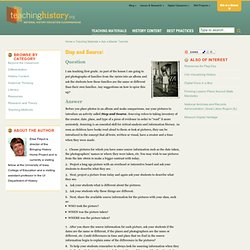
Sourcing refers to taking inventory of the creator, date, place, and type of a piece of evidence in order to “read” it more accurately. Sourcing is an essential skill for critical analysis and information literacy. As soon as children have books read aloud to them or look at pictures, they can be introduced to the concept that all texts, written or visual, have a creator and a time when they were made. Choose pictures for which you have some source information such as the date taken, the photographers’ names or where they were taken, etc. You may wish to use pictures from the late 1800s to make a bigger contrast with today.Project a long ago picture with an overhead or interactive board and ask your students to describe what they see. Bibliography. Sifting for Sources.
It’s exciting that you are engaging your second graders in historical source analysis!
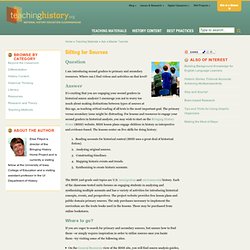
I encourage you not to worry too much about making distinctions between types of sources at this age, as teaching critical reading of all texts is the most important goal. The primary versus secondary issue might be distracting. For lessons and resources to engage your second graders in historical analysis, you may wish to start on the Bringing History Home (BHH) website. BHH lesson plans engage children in history as interpretive and evidence-based. The lessons center on five skills for doing history: Reading accounts for historical context (BHH uses a great deal of historical fiction).Analyzing original sources.Constructing timelines.Mapping historic events and trends.Synthesizing to create historic accounts.
The BHH 2nd-grade unit topics are U.S. immigration and environmental history. Teaching Perspective. Multiple Perspectives Examining historical events from multiple perspectives introduces elementary students to core aspects of history and historical thinking.
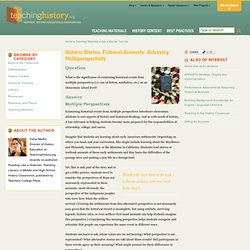
And as with much of history, it has relevance to helping students become more prepared for the responsibilities of citizenship, college, and career. Imagine that students are learning about early American settlements. Depending on where you teach and your curriculum, this might include learning about the Mayflower and Plymouth, Jamestown, or the Missions in California. Students read stories or textbook accounts of these early settlements and they learn the difficulties of the passage here and making a new life in a foreign land. Students can learn to ask, whose voices are we not hearing? Students can learn to ask, whose voices are we not hearing? Reading in the History Classroom.
In their article “Teaching Disciplinary Literacy to Adolescents: Rethinking Content-Area Literacy,” Timothy Shanahan and Cynthia Shanahan provide insight into the different reading skills required for success in different disciplines.
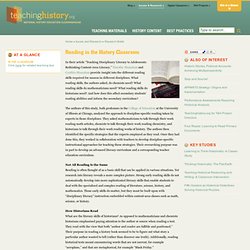
What reading skills, the authors asked, do chemists need? What reading skills do mathematicians need? What reading skills do historians need? And how does this affect secondary students’ reading abilities and inform the secondary curriculum? The authors of this study, both professors in the College of Education at the University of Illinois at Chicago, analyzed the approach to discipline-specific reading taken by experts in those disciplines.
Not All Reading Is the Same Reading is often thought of as a basic skill that can be applied in various situations. How Historians Read What are the literacy skills of historians? A History Events Chart One strategy was a “history events chart.” In the Classroom Sample Application For more information Bibliography. Reading Primary Sources. What is it?
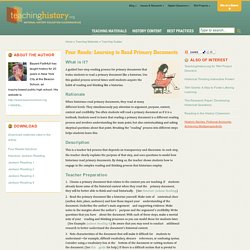
A guided four-step reading process for primary documents that trains students to read a primary document like a historian. Use this guided process several times until students acquire the habit of reading and thinking like a historian. Rationale When historians read primary documents, they read at many different levels. They simultaneously pay attention to argument, purpose, context, content and credibility. Description This is a teacher-led process that depends on transparency and discussion. Teacher Preparation Choose a primary document that relates to the content you are teaching. In the Classroom Introduce the activity Give a copy of the primary document to each student.
Consider projecting the document on a screen so that you can model the kinds of observations that a historian makes and the kinds of questions she asks.